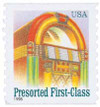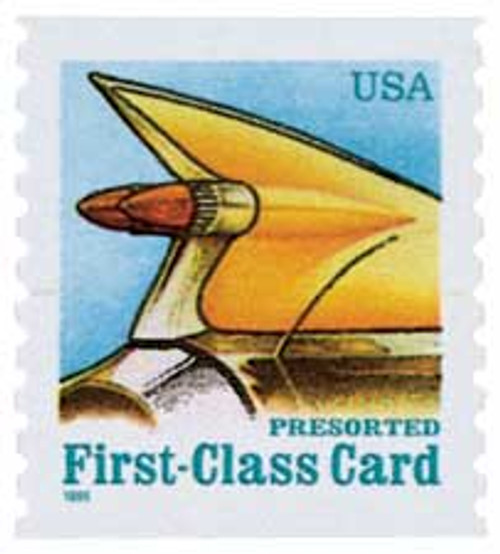
# 2912 - 1995 25c Juke Box, SV coil
US #2912
1995 Juke Box
- Part of the American Culture series
- Covered the Presorted First-Class rate
Category of Stamp: Definitive
Set: American Culture
Value: 25¢, Presorted First-Class Bulk rate
First Day of Issue: March 17, 1995
First Day City: New York, New York
Quantity Issued: 150,000,000
Printed by: Stamp Venturers
Printing Method/Format: Photogravure, Coils of10,000 from printing cylinders of 616 subjects (22 across, 28 down)
Perforations: 9.8
Reason the stamp was issued: It was issued to pay the postage for the first-class, presort letter rate.
About the stamp design: The stamp pictures a Wurlitzer Model 1015 Jukebox, the most popular of the automatic record players. Bill Nelson created the image for this stamp, along with the Auto Tail Fin.
About the printing process: This coil stamp was produced by two printers: the Bureau of Engraving and Printing and Stamp Venturers.
First Day City: The First Day of Issue ceremony took place during the Postage Stamp Mega-Event in New York City.
About the American Culture series: Three new definitive coil series were introduced in 1995: “American Scenes,” “American Transportation,” and “American Culture.”
The American Culture series shows items of our nation’s popular culture. The art director for the series, Carl Herrman, said, “The series tries to take a look at American creativity and at things that no other country could claim.”
The 15¢ Automobile Tail Fin stamp features the fin of a 1959 Cadillac, and was used for presorted first-class postcards. The 25¢ Juke Box coil stamp was intended for presorted first-class letters.
The 25¢ Diner stamp was issued in 1998. It pictures a typical restaurant popular in the middle of the 20th century.
In 2000, the New York Public Library Lions stamp was issued. The image is a contemporary rendition of one of the statues located at the Fifth Avenue entrance to the Library.
The Woody Wagon stamp design is based on the wood-paneled vehicles produced between 1929 and 1953 and used variously to transport guests to and from railroad stations, to accommodate family travel, and to carry surfers and their surfboards to the beach. The stamp pictures a 1949 Ford wagon with a surfboard hanging out the back.
The 10¢ Atlas stamp is based on a photograph by Horst Hamann of the Atlas Statue that stands outside Rockefeller Center in New York City. Lee Lawrie created the Atlas sculpture in 1937, and Kenneth Lynch made the skeletal, heavenly spheres that Atlas supports.
The design for the Wisdom stamp in the American Culture Series was taken from Lee Lawrie's art deco sculpture, "Wisdom With Light and Sound," at Rockefeller Center in New York City. Words beneath the relief sculpture are from Isaiah 33:6 in the Old Testament: "Wisdom and knowledge shall be the stability of thy time." The Wisdom stamp is the only issue in the American Culture Series that is not a coil stamp.
History the stamp represents: The Jukebox began its popularity in the 1930s. After World War II, they appeared in dance halls and diners all across the country. One of the most popular models was the Wurlitzer 1015. It combined art deco designs with plastic – a new material developed during the war. In 1946, the company sold over 56,000 of these Jukeboxes.
US #2912
1995 Juke Box
- Part of the American Culture series
- Covered the Presorted First-Class rate
Category of Stamp: Definitive
Set: American Culture
Value: 25¢, Presorted First-Class Bulk rate
First Day of Issue: March 17, 1995
First Day City: New York, New York
Quantity Issued: 150,000,000
Printed by: Stamp Venturers
Printing Method/Format: Photogravure, Coils of10,000 from printing cylinders of 616 subjects (22 across, 28 down)
Perforations: 9.8
Reason the stamp was issued: It was issued to pay the postage for the first-class, presort letter rate.
About the stamp design: The stamp pictures a Wurlitzer Model 1015 Jukebox, the most popular of the automatic record players. Bill Nelson created the image for this stamp, along with the Auto Tail Fin.
About the printing process: This coil stamp was produced by two printers: the Bureau of Engraving and Printing and Stamp Venturers.
First Day City: The First Day of Issue ceremony took place during the Postage Stamp Mega-Event in New York City.
About the American Culture series: Three new definitive coil series were introduced in 1995: “American Scenes,” “American Transportation,” and “American Culture.”
The American Culture series shows items of our nation’s popular culture. The art director for the series, Carl Herrman, said, “The series tries to take a look at American creativity and at things that no other country could claim.”
The 15¢ Automobile Tail Fin stamp features the fin of a 1959 Cadillac, and was used for presorted first-class postcards. The 25¢ Juke Box coil stamp was intended for presorted first-class letters.
The 25¢ Diner stamp was issued in 1998. It pictures a typical restaurant popular in the middle of the 20th century.
In 2000, the New York Public Library Lions stamp was issued. The image is a contemporary rendition of one of the statues located at the Fifth Avenue entrance to the Library.
The Woody Wagon stamp design is based on the wood-paneled vehicles produced between 1929 and 1953 and used variously to transport guests to and from railroad stations, to accommodate family travel, and to carry surfers and their surfboards to the beach. The stamp pictures a 1949 Ford wagon with a surfboard hanging out the back.
The 10¢ Atlas stamp is based on a photograph by Horst Hamann of the Atlas Statue that stands outside Rockefeller Center in New York City. Lee Lawrie created the Atlas sculpture in 1937, and Kenneth Lynch made the skeletal, heavenly spheres that Atlas supports.
The design for the Wisdom stamp in the American Culture Series was taken from Lee Lawrie's art deco sculpture, "Wisdom With Light and Sound," at Rockefeller Center in New York City. Words beneath the relief sculpture are from Isaiah 33:6 in the Old Testament: "Wisdom and knowledge shall be the stability of thy time." The Wisdom stamp is the only issue in the American Culture Series that is not a coil stamp.
History the stamp represents: The Jukebox began its popularity in the 1930s. After World War II, they appeared in dance halls and diners all across the country. One of the most popular models was the Wurlitzer 1015. It combined art deco designs with plastic – a new material developed during the war. In 1946, the company sold over 56,000 of these Jukeboxes.




















